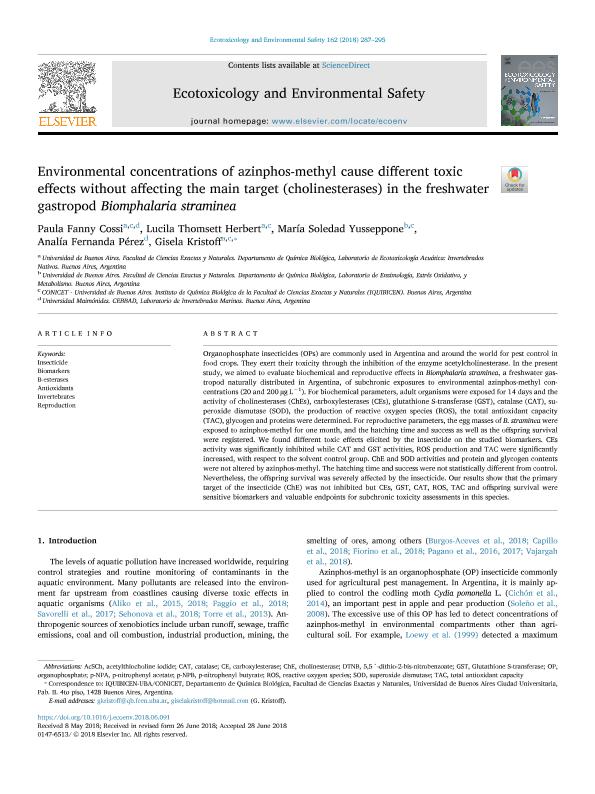Mostrar el registro sencillo del ítem
dc.contributor.author
Cossi, Paula Fanny

dc.contributor.author
Herbert, Lucila Thomsett

dc.contributor.author
Yusseppone, Maria Soledad

dc.contributor.author
Pérez, Analía Fernanda

dc.contributor.author
Kristoff, Gisela

dc.date.available
2019-10-30T19:54:22Z
dc.date.issued
2018-10
dc.identifier.citation
Cossi, Paula Fanny; Herbert, Lucila Thomsett; Yusseppone, Maria Soledad; Pérez, Analía Fernanda; Kristoff, Gisela; Environmental concentrations of azinphos-methyl cause different toxic effects without affecting the main target (cholinesterases) in the freshwater gastropod Biomphalaria straminea; Academic Press Inc Elsevier Science; Ecotoxicology and Environmental Safety; 162; 10-2018; 287-295
dc.identifier.issn
0147-6513
dc.identifier.uri
http://hdl.handle.net/11336/87702
dc.description.abstract
Organophosphate insecticides (OPs) are commonly used in Argentina and around the world for pest control in food crops. They exert their toxicity through the inhibition of the enzyme acetylcholinesterase. In the present study, we aimed to evaluate biochemical and reproductive effects in Biomphalaria straminea, a freshwater gastropod naturally distributed in Argentina, of subchronic exposures to environmental azinphos-methyl concentrations (20 and 200 µg L−1). For biochemical parameters, adult organisms were exposed for 14 days and the activity of cholinesterases (ChEs), carboxylesterases (CEs), glutathione S-transferase (GST), catalase (CAT), superoxide dismutase (SOD), the production of reactive oxygen species (ROS), the total antioxidant capacity (TAC), glycogen and proteins were determined. For reproductive parameters, the egg masses of B. straminea were exposed to azinphos-methyl for one month, and the hatching time and success as well as the offspring survival were registered. We found different toxic effects elicited by the insecticide on the studied biomarkers. CEs activity was significantly inhibited while CAT and GST activities, ROS production and TAC were significantly increased, with respect to the solvent control group. ChE and SOD activities and protein and glycogen contents were not altered by azinphos-methyl. The hatching time and success were not statistically different from control. Nevertheless, the offspring survival was severely affected by the insecticide. Our results show that the primary target of the insecticide (ChE) was not inhibited but CEs, GST, CAT, ROS, TAC and offspring survival were sensitive biomarkers and valuable endpoints for subchronic toxicity assessments in this species.
dc.format
application/pdf
dc.language.iso
eng
dc.publisher
Academic Press Inc Elsevier Science

dc.rights
info:eu-repo/semantics/openAccess
dc.rights.uri
https://creativecommons.org/licenses/by-nc-nd/2.5/ar/
dc.subject
insecticide
dc.subject
antioxidants
dc.subject
invertebrates
dc.subject
reproduction
dc.subject
biomarkers
dc.subject
B-esterases
dc.subject.classification
Otras Ciencias de la Tierra y relacionadas con el Medio Ambiente

dc.subject.classification
Ciencias de la Tierra y relacionadas con el Medio Ambiente

dc.subject.classification
CIENCIAS NATURALES Y EXACTAS

dc.title
Environmental concentrations of azinphos-methyl cause different toxic effects without affecting the main target (cholinesterases) in the freshwater gastropod Biomphalaria straminea
dc.type
info:eu-repo/semantics/article
dc.type
info:ar-repo/semantics/artículo
dc.type
info:eu-repo/semantics/publishedVersion
dc.date.updated
2019-10-24T19:04:23Z
dc.journal.volume
162
dc.journal.pagination
287-295
dc.journal.pais
Estados Unidos

dc.journal.ciudad
Amsterdam
dc.description.fil
Fil: Cossi, Paula Fanny. Universidad Maimónides; Argentina. Consejo Nacional de Investigaciones Científicas y Técnicas. Oficina de Coordinación Administrativa Ciudad Universitaria. Instituto de Química Biológica de la Facultad de Ciencias Exactas y Naturales. Universidad de Buenos Aires. Facultad de Ciencias Exactas y Naturales. Instituto de Química Biológica de la Facultad de Ciencias Exactas y Naturales; Argentina
dc.description.fil
Fil: Herbert, Lucila Thomsett. Universidad de Buenos Aires; Argentina. Consejo Nacional de Investigaciones Científicas y Técnicas. Oficina de Coordinación Administrativa Ciudad Universitaria. Instituto de Química Biológica de la Facultad de Ciencias Exactas y Naturales. Universidad de Buenos Aires. Facultad de Ciencias Exactas y Naturales. Instituto de Química Biológica de la Facultad de Ciencias Exactas y Naturales; Argentina
dc.description.fil
Fil: Yusseppone, Maria Soledad. Universidad de Buenos Aires; Argentina. Consejo Nacional de Investigaciones Científicas y Técnicas. Centro Científico Tecnológico Conicet - Mar del Plata. Instituto de Investigaciones Marinas y Costeras. Universidad Nacional de Mar del Plata. Facultad de Ciencias Exactas y Naturales. Instituto de Investigaciones Marinas y Costeras; Argentina
dc.description.fil
Fil: Pérez, Analía Fernanda. Universidad Maimónides; Argentina
dc.description.fil
Fil: Kristoff, Gisela. Universidad de Buenos Aires; Argentina
dc.journal.title
Ecotoxicology and Environmental Safety

dc.relation.alternativeid
info:eu-repo/semantics/altIdentifier/url/https://doi.org/10.1016/j.ecoenv.2018.06.091
dc.relation.alternativeid
info:eu-repo/semantics/altIdentifier/doi/http://dx.doi.org/10.1016/j.ecoenv.2018.06.091
Archivos asociados
